Perhaps it is no exaggeration to say that Giovanni Paolo Panini is rightfully among that select group of artists who can claim to have not one, but two dates of birth. In Panini’s case, the first is the date on which he was born in Piacenza, June 17, 1691. The second, on the other hand, is 1961, the date on which the first monograph dedicated to him was published, a challenging work by Ferdinando Arisi, an art historian from Piacenza who was for a long time director of the Ricci Oddi Gallery, and an authentic “discoverer” (allow me to use the inelegant term, but apt to render the idea well) of the historical and artistic importance of Panini’s art. Every great painter, of course, has had a scholar dedicate to him an early monograph drafted in modern terms. For Panini, however, it is different, because Arisi’s fundamental studies have illuminated his art with an entirely new clarity. It is as if someone discovered a talented actor in a provincial theater and brought him to the stages of Broadway. And on this artist, until then little considered by critics, rained an enduring international fortune, as befitted a painter of such magnitude, a very fine interpreter of a nascent taste, a modern landscape painter free from academic rules, a sincere lover of the ruins of ancient Rome. There had, of course, been isolated appreciations before Arisi’s decisive research. For example, Aldo de Rinaldis, whose name is inextricably linked to the National Museum of Capodimonte and who during World War II distinguished himself as one of our most talented monuments men, called Panini “a central figure” in the “history of perspective painting,” on a par with Giovanni Ghisolfi. For Adolfo Venturi, Panini was the “greatest representative in Rome, ahead of the Venetian Piranesi, of the great painting of villages and ruins that flourished in the first half of the 18th century.” Never, however, had the true dimension of his inspiration emerged with more disruptive force.
Arisi’s contributions, later further developed in another monograph in 1986 and resulting in a major exhibition organized in 1993 at Piacenza’s Gotico, ignited critical and market attention on Panini, sent the prices of his works soaring (his auction record is $5.3 million), and effectively opened the way for his entry into all art history textbooks. Today Panini is studied in high school art class. Yet despite the blossoming of studies on Panini, some areas remain to be thoroughly investigated: these include his education, on which several unsolved aspects still hang. And now, until March 19, an exhibition at the Biffi Arte Gallery in Piacenza asks precisely about the early Panini, with an excellent dossier review cleverly built around the solid points of the early stages of his career: it is entitled Giovanni Paolo Panini, un dossier piacentino. Formation between Piacenza and Rome, and is curated by Marco Horak and Fabio Obertelli.
The exhibition, with a continuous interweaving of data now firmly established within Panini historiography and new proposals and hypotheses, reconstructs the environments in which the young artist was able to complete his training: on the one hand, the Piacenza of the early eighteenth century, which found itself to be a crossroads of Lombard, Emilian and Ligurian artists by reason of the fact that, since there was no local school in the city, those who wanted to have their palaces decorated or have a picture painted according to the most up-to-date taste were practically obliged to turn outside the city limits. On the other, the fascinating Rome to which Panini had moved as a 20-year-old in 1711, destined to link his name forever to that of the Eternal City. First a pupil of Benedetto Luti, he then refined his qualities by looking at all the best that Rome could offer him: principally Salvator Rosa and Giovanni Ghisolfi, although Panini’s contacts and interests were, in all likelihood, far more extensive than those traditionally credited to this painter who helped establish “a current that we can define as Roman vedutismo of the 18th century,” Horak states in the catalog, although it is acknowledged that the invention of the genre belongs to the less fortunate Ghisolfi, who died in 1683. Nevertheless, Panini would have the opportunity, after an initial period in which he merely “paraphrased Ghisolfi in a manner that seems justified to call shameless,” Arisi had to write, to update the language of the ideal master, whom he never had the opportunity to meet in person for obvious anagraphic reasons, but whose painting he assimilated and then reworked in a modern, personal, original way, so much so that his views and capriccios remained an inescapable reference for Giovanni Battista Piranesi himself, whose views of ancient Rome would perhaps be difficult to explain without the contribution Panini guaranteed to the genre.
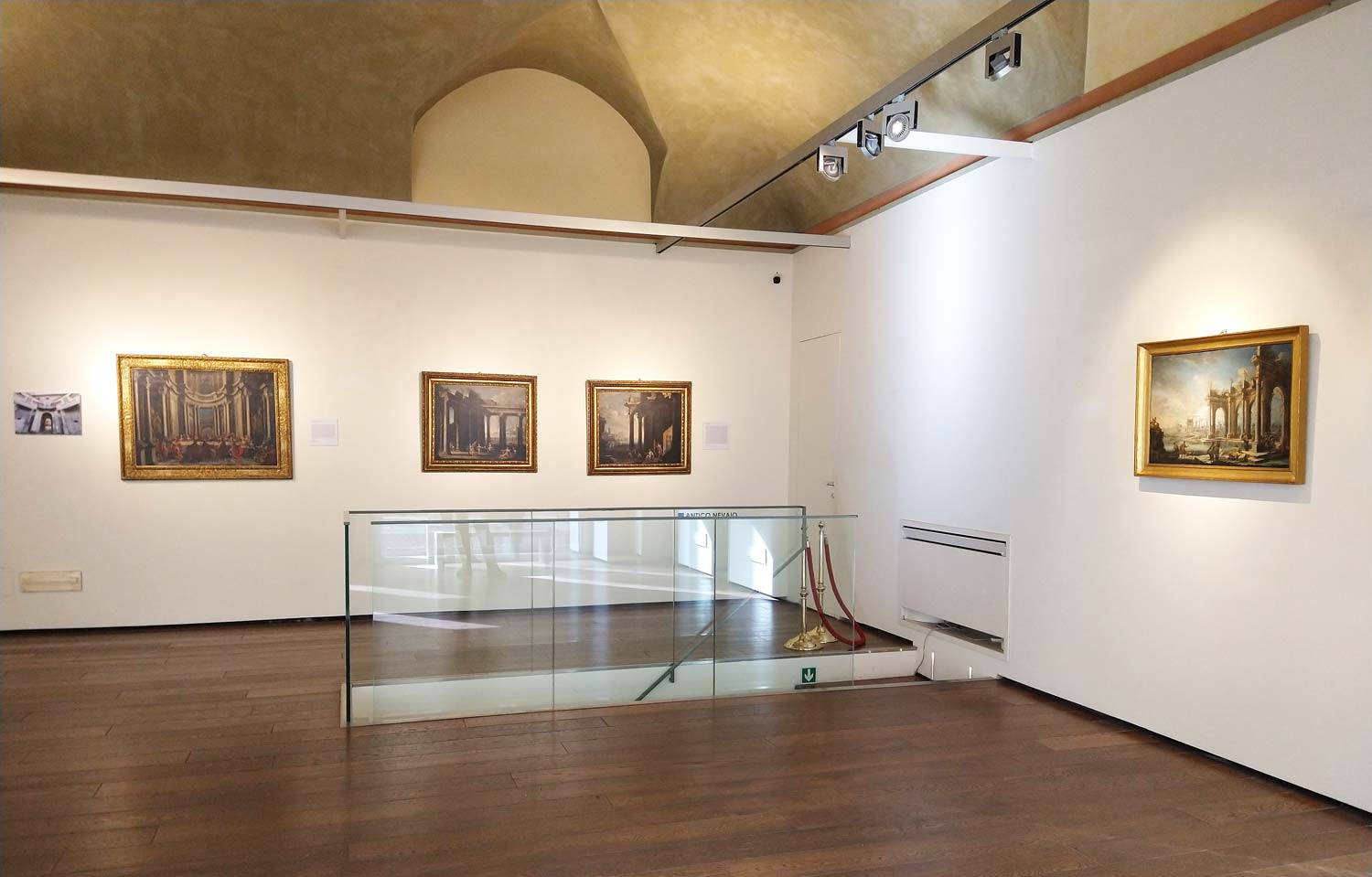
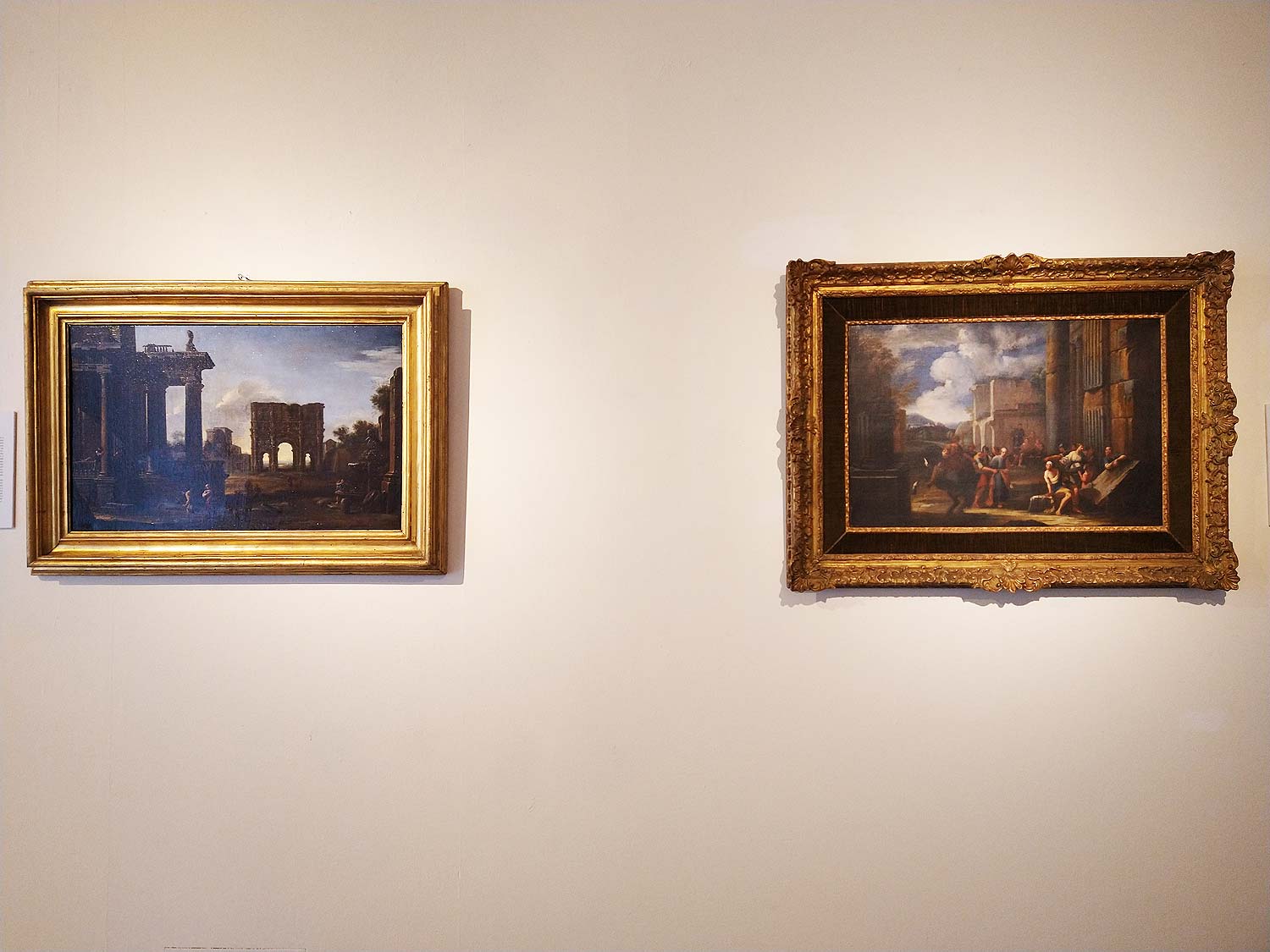
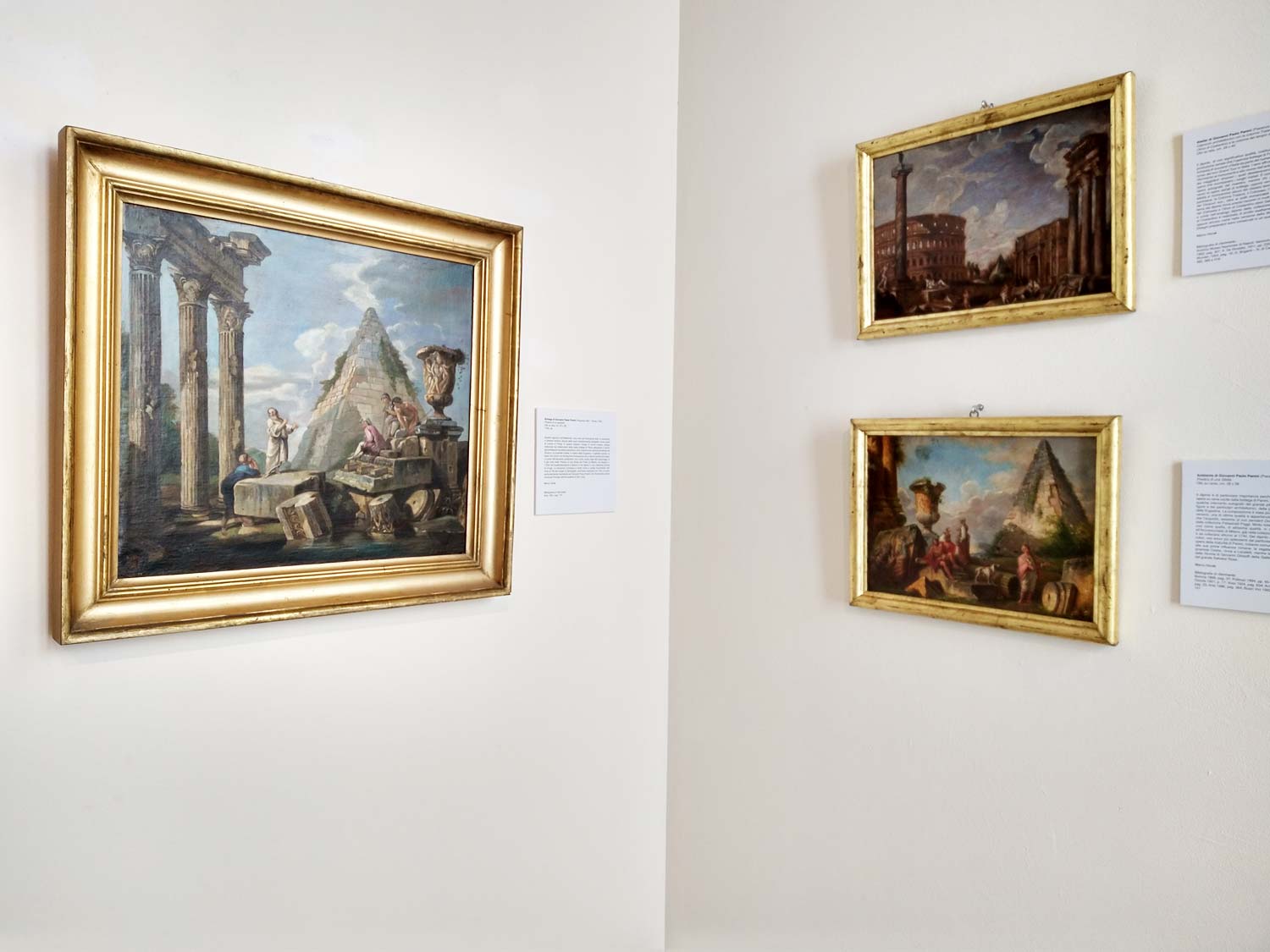
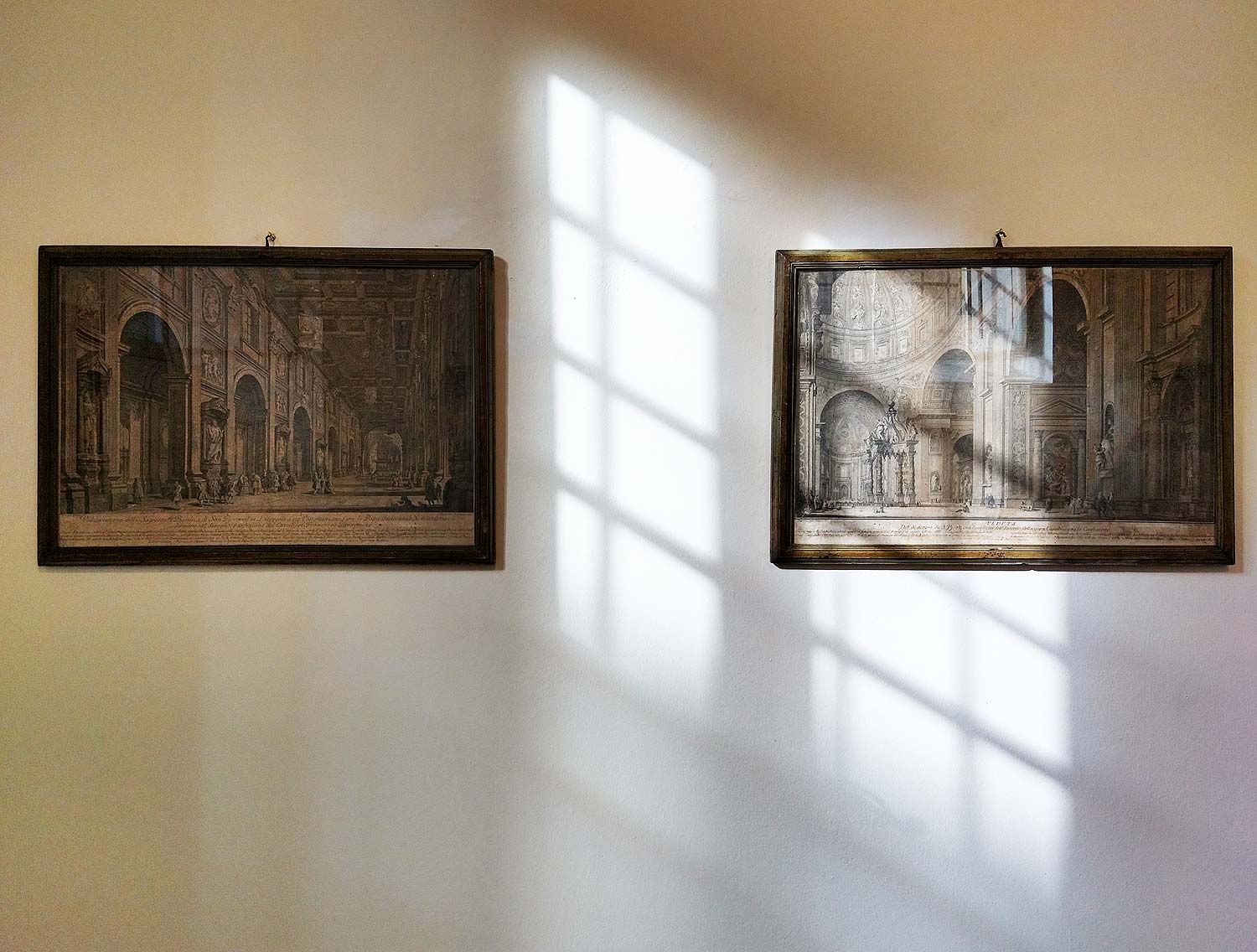
In order to give the visitor back the image of Panini (note, it has not yet been mentioned, that the exhibition preferred this redaction of his surname and not the perhaps more widespread one of “Pannini,” since the artist signed with a single “N.” the variant with the double was already widespread in the eighteenth century, however, especially in French circles), the visiting itinerary opens with a fine portrait of the artist, executed by Charles Natoire, to whose catalog a recent addition has been made, and of which more will be said at length in the conclusion, since the public visiting the exhibition will leave from where they entered thus seeing the painting of the painter from Nîmes first and last. We enter immediately into the heart of the exhibition with a series of architectural engravings by Giuseppe Galli Bibiena, taken from the collection Architectures and Perspectives dedicated to the Majesty of Charles the Sixth Emperor: these compositions, in addition to testifying to Panini’s relationship with the younger Galli Bibiena, are intended above all to give an account of the environment in which the young Panini was formed. In particular, it was Giuseppe’s father, Ferdinando Galli Bibiena, who carved out a prominent role for himself in Farnese Piacenza: endowed with a singular imaginative flair, he invented scenographic solutions that would change the city forever (we need only think of Palazzo Costa, or the church of San Cristoforo, today the site of the Piccolo Museo della Poesia: the spectacular decorative apparatus is owed to Bibiena) and which must have had some influence on the young Panini, who not even eighteen years old, in 1708, found himself composing a treatise on perspective, the result of his evident interest in what he had to see around him in his hometown.
A hometown that enters fully into the first two paintings that can be assigned to him with a good margin of certainty: they are a pendant with two Architectural Compositions that imaginatively rework the Gothic style of Piacenza, also executed by a Panini who must have been still seventeen years old or so. One of the two views is from the Glauco Lombardi Museum in Parma and is on display, while the other belongs to a private collection in Piacenza and is present with a reproduction based on an old photograph. The two paintings were traced back to Panini by Arisi and are the most tangible evidence of the Piacenza artist’s gaze toward Ferdinando Galli Bibiena: “immature” works, as Marco Horak defines them, they are still far from the quality of which the artist would be capable in the continuation of his career, and their importance is first and foremost due to the fact that they nevertheless represent Panini’s “first work,” offer an essay of his inventiveness since they are not mere views, but a free interpretation, if you want to call it that, of a real existing building (all the more so since it is the symbol of his city), and they are proof of a painter who was in any case measuring himself with the genre of painted architecture.
In order to admire a Panini who was still young, but more mature and perhaps more aware of his own means, as well as strong in new experiences and new knowledge, it is necessary to move a little further on, where the curators propose a comparison between a Capture of St. Peter set within a backdrop of ancient ruins, and an Architectural Capriccio by Giovanni Ghisolfi, the artist to whom, as mentioned above, Panini looked after his move to Rome. Ghisolfi’s painting is an essay of the genre that he himself developed: the Milanese artist, however, would soon be outclassed by Panini, who would significantly and decisively modernize the free reinterpretation of monuments of ancient Rome. Here we see the Arch of Constantine, in the center of the composition, with a building with a portico of Ionic columns in the foreground: it is a particularly relevant example of Ghisolfi’s compositional felicity as well as the pleasing charm of his painting, characteristics that determined his success. The Capture of St. Peter, moreover a rare iconographic subject, is one of the young Panini’s most problematic paintings, which here reveals a close adherence to Ghisolfi’s manner, so much so that the painting has recently assigned to Ghisolfi himself, while on the occasion of the exhibition Horak again ascribed it to Panini mainly on account of the detail of the prancing horse, judged to be completely foreign to Ghisolfi’s production (where, however, there is no shortage of paintings with figures), whereas on the contrary it is recurrent in some of Panini’s paintings. Instead, the artist proves far more autonomous in a pair of paintings, Christ and the Adulteress and The Probate Pool, which constitute a pair of unpublished works. Much more airy paintings than their predecessors, with the architecture all shifted to one side leaving wide open spaces to reveal, especially in the case of The Probatic Pool, dense urban fabrics that are lost in the distance, they are considered almost hapaxes in the young Panini’s production (to which they have been referred because of the presence of the JP monogram on the Probatic Pool): “the style,” writes Obertelli in the catalog, “does not speak the most commonly known and identifiable Panini idiom,” since this is a case, probably unique, in which the artist’s language opens toward certain solutions of the Neapolitan Gennaro Greco. They hark back to these, for example, the idea of dividing architecture and landscape so sharply by giving so much space to the sky, or again “the double loggia on quayside with sub-arched pool and the chromatic treatment of the structures, in two-tone marbling,” as the curator argues, as well as the “backlighting treatment of the most prospective details.” There are works by Greco that are extremely similar to these two by Panini. However, it is not known if and how Panini came in contact with Greco: Obertelli’s hypothesis is that the intermediary may have been a mutual acquaintance, namely Sebastiano Conca.
The roundup continues with the largest painting among those in the exhibition: it is a composition of Ruins with Figures published by Arisi in his 1986 monograph, datable to around 1719. Given the format of the painting, Panini indulges here in broader, more expansive brushstrokes and less attention to detail, succeeding, however, in a pleasing and balanced work, with a structure in the background that seems to anticipate the Piscina probatica (which, according to Obertelli, is later than this painting). We continue with another pendant: Two Architectural Capriccios with Figures of dubious attribution, since they have been assigned in the past to both Panini and the Roman Alberto Carlieri, another figure toward whom the young Piacentine’s gaze was turned in Urbe (and Carlieri, in turn, looked to Ghisolfi). These are two paintings of great quality, with impeccable architecture, foreshortened diagonally, much more balanced in relation to space than Carlieri’s decidedly denser ones, as well as typical of Panini now approaching artistic maturity, but nevertheless populated with figures that are not found in his art and are instead far more compatible with Carlieri’s. It must be said that the right-hand side of the composition of the second capriccio, the one with the blade of light passing through the archway’s fornix, is quite similar to the portion of a painting passed at auction by Koller in 2015, attributed to Carlieri by David R. Marshall (i.e., the scholar who assigned the Roman painter the two paintings in the exhibition), with the figures posed in poses not so distant from those in the painting on display. This is not a decisive element in settling a difficult attribution question that is also left unresolved in the exhibition, but it can nevertheless provide a useful opportunity for comparison. On the same wall, to end the tour of the room, here then is the Convito di Baldassarre re di Babilonia, a work that, writes Marco Horak, “presents with great evidence the influence that the illusionistic architectural solutions of the Bibiena and perhaps also the compositions of Alberto Carlieri still exerted on the painter.” The scholar points out in particular a correspondence between the semicircular architecture of this painting, and that made by Gian Carlo Novati, pupil and collaborator of the Bibiena for the circular courtyard of Palazzo Novati in Piacenza. Finally, it is a work that can be considered the conclusion of Panini’s early Roman period, as well as of the early phase of his career, the one still marked by a close proximity to the manners of his ideal masters.
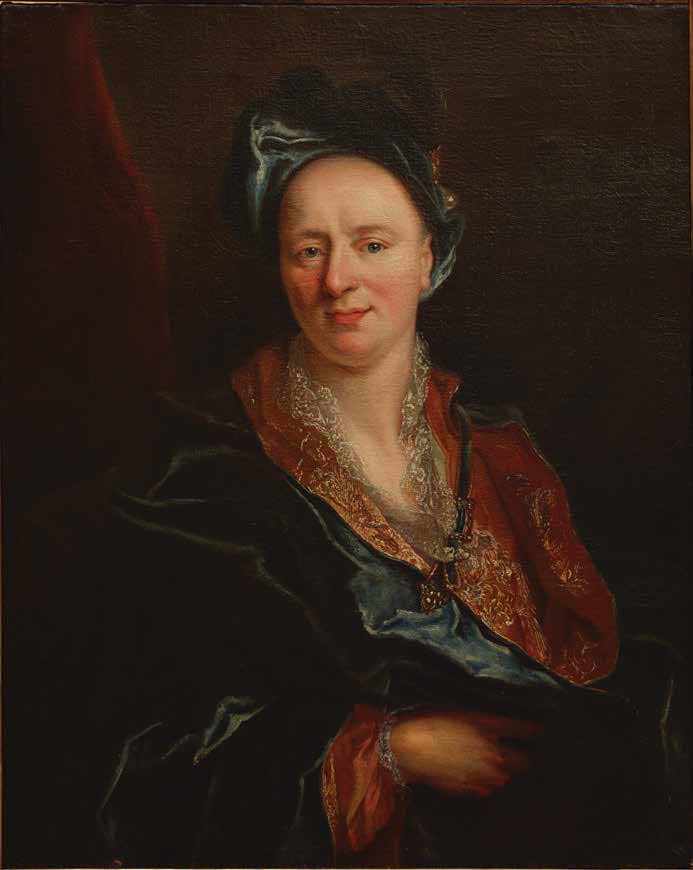

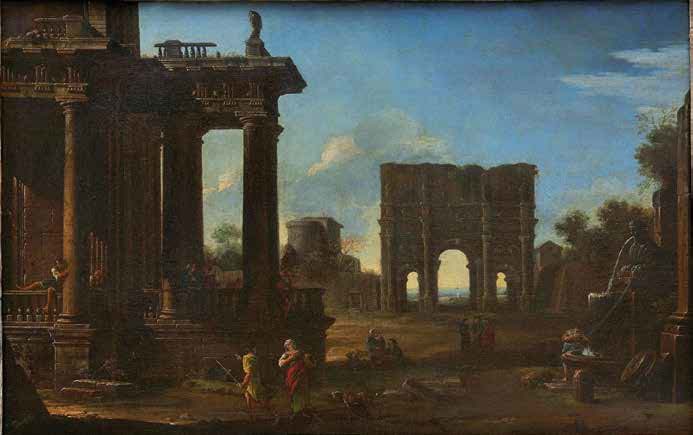
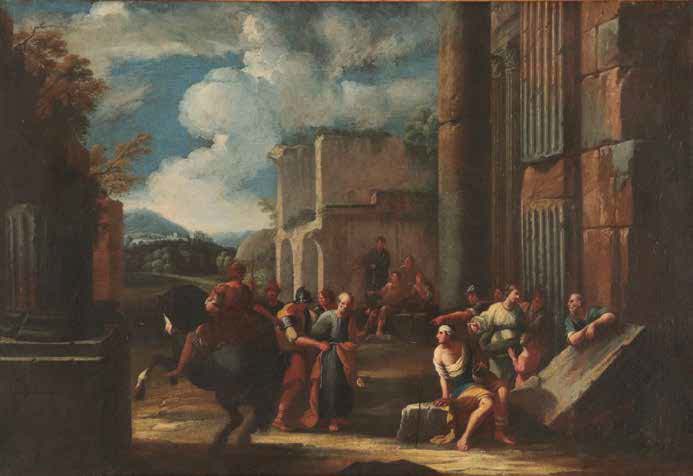
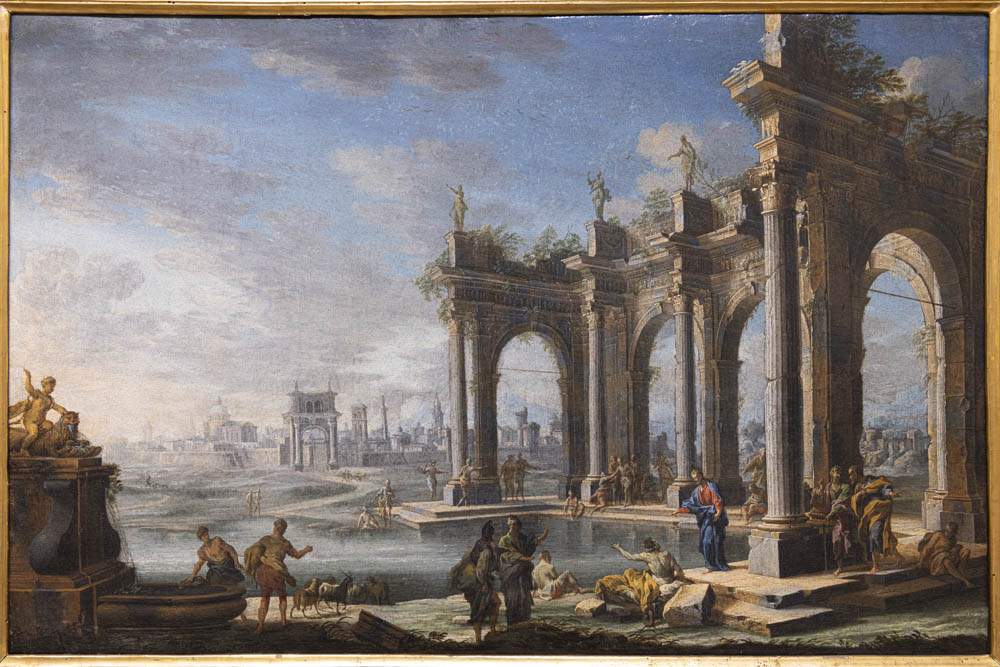 Giovanni Paolo Panini,
Giovanni Paolo Panini,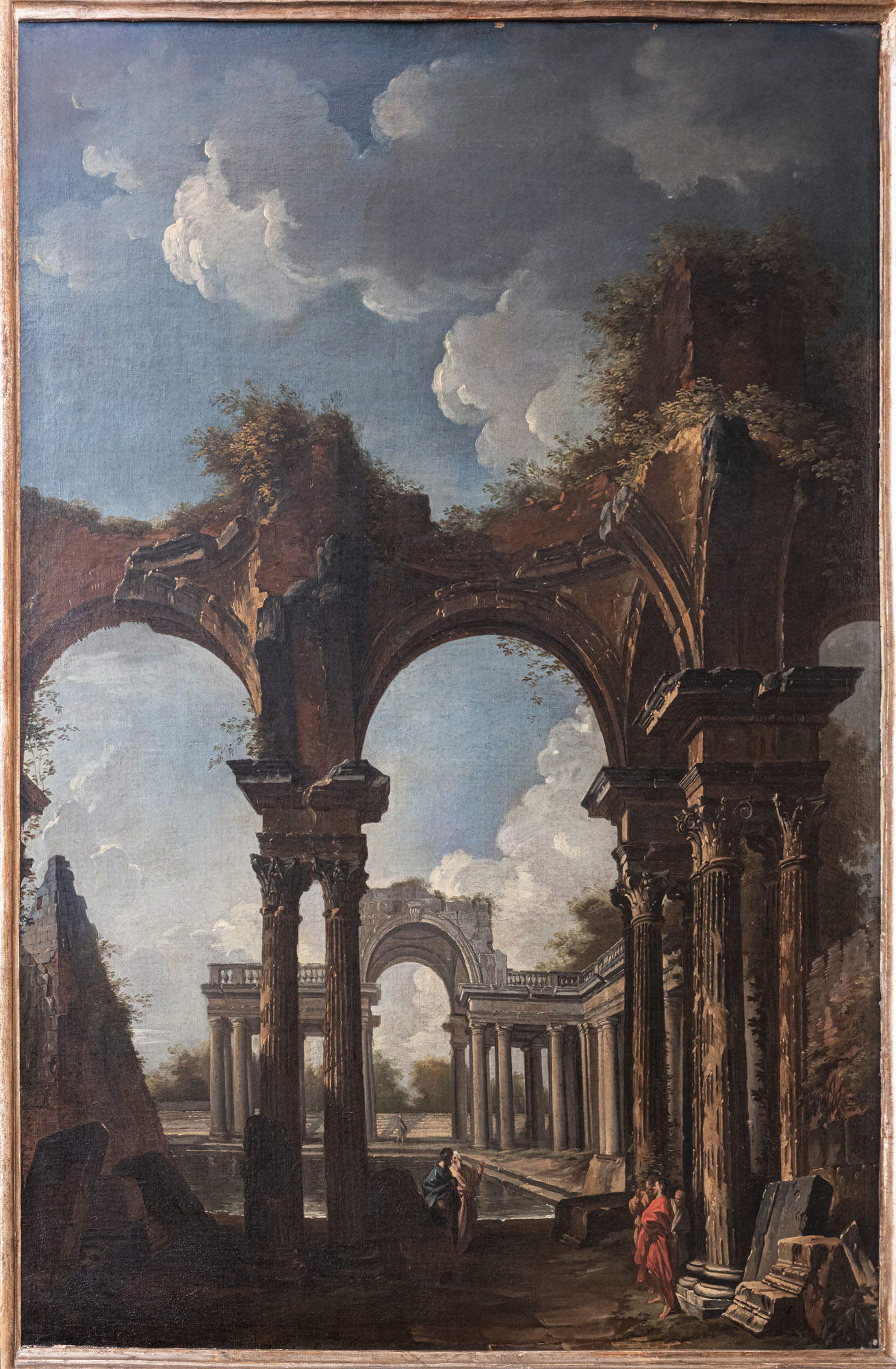

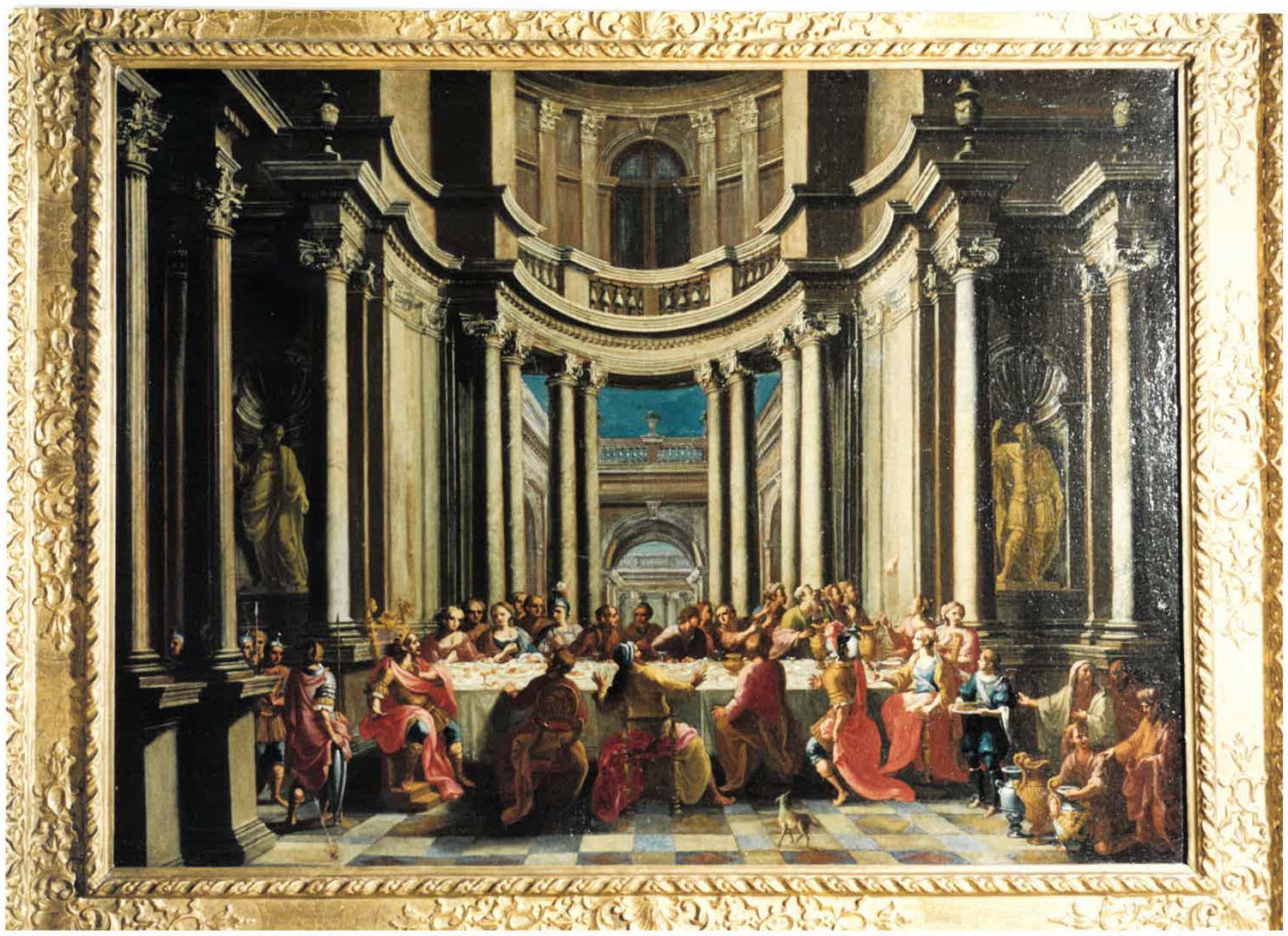
The exhibition also gives an account of the mature Panini, to offer the public effective and useful terms of comparison. There are two paintings referable to the later stage of his career: a Preaching of an Apostle, set in a fictional Roman setting where, however, real existing monuments can be recognized, although reworked in their proportions (on the right here, therefore, is the Pyramid of Cestia, and on the left the three surviving columns of the Temple of the Càstori), and which opens onto a sky with decidedly lighter tones than those of the paintings closer to Ghisolfi. Even more indicative, however, is the painting that closes the exhibition, a canvas depicting Roman Ruins with Marcus Aurelius, lent by the Banca di Piacenza, and dating from the 1850s, when Panini was by then at the height of his success. The scene takes place on a flight of steps, populated by a number of figurines, enclosed on the right by the pronaos of the Pantheon and at the bottom by an exedra, and above which stand out on one side the remains of the temple of Vespasian and on the other the monument of Marcus Aurelius, a rather recurring presence in Panini’s whims. Paintings like this one were precious souvenirs requested from Panini by his wealthy international clientele, and the idea of putting together clearly recognizable monuments of ancient Rome satisfied a precise demand of the buyers (there is, moreover, a slightly larger version of this painting preserved in the Louvre, where there is also a painting with the Pyramid Cestia that follows a similar composition to that of the painting exhibited at the Biffi Arte Gallery just mentioned). These are paintings that testify to Panini’s turning point starting in the 1930s, a period from which the artist “would orient his production,” Horak writes, “moving from the typical compositions of a painter of architectural whims (works most often of fantasy) to the more appreciable ones of a vedutista, through the representation of architectural landscapes of wide-ranging and enlarged perspective.” A turnaround made possible by the encounter of French painting (above all that of the Parisian Nicolas Vleughels, who became director of the Académie de France in Rome in 1724), which would result in a remarkable brightening of the palette and the inclusion of broader and deeper perspectives.
The exhibition does not neglect the works of Panini’s workshop, to highlight the differences between the master and his collaborators, evident in the qualitative deviations (seen, for example, in the Capriccio architettonico with the Trajan Column, the Colosseum the Arch of Constantine and the columns of the temple of the Dioscuri, characterized by a rapid and hasty brushstroke, and by summarily painted figures), as well as to introduce the theme of seriality in the production of a flourishing workshop, to which in the central decades of the eighteenth century commissions were continually arriving, with the consequence that works that were far from sublime were often produced for less demanding clients or those with fewer economic resources. Within the workshop production, however, there is no lack of works of a certain interest: this is the case, for example, of a rare oil on copper, among the very few that came out of Panini’s atelier, a scaled-down replica of the painting of the Cestia Pyramid in the Louvre mentioned earlier. The closing of the exhibition falls to some interesting engravings. Not to be missed is theInterior of the Pantheon in Rome executed by Englishman Charles Knapton from a drawing by Panini, as well as two rarities such as Claude Henri Watelet’s engravings from two Landscapes with Ruins by Panini, to which Horak devotes an essay in the exhibition catalog. These are prints of great quality included in the exhibition to testify to the international notoriety achieved by Panini still operating. And finally, an entire room is devoted to the engravings of Francesco Panini, son of Giovanni Paolo, heir to his workshop, albeit neglected by critics despite being among the most interesting engravers of the 18th century. The exhibition features nine plates from two different series: particularly impressive are the Three architectural views engraved and brought back on canvas, characterized by a pictoricism that is the most eloquent proof of this artist’s neglected talent.
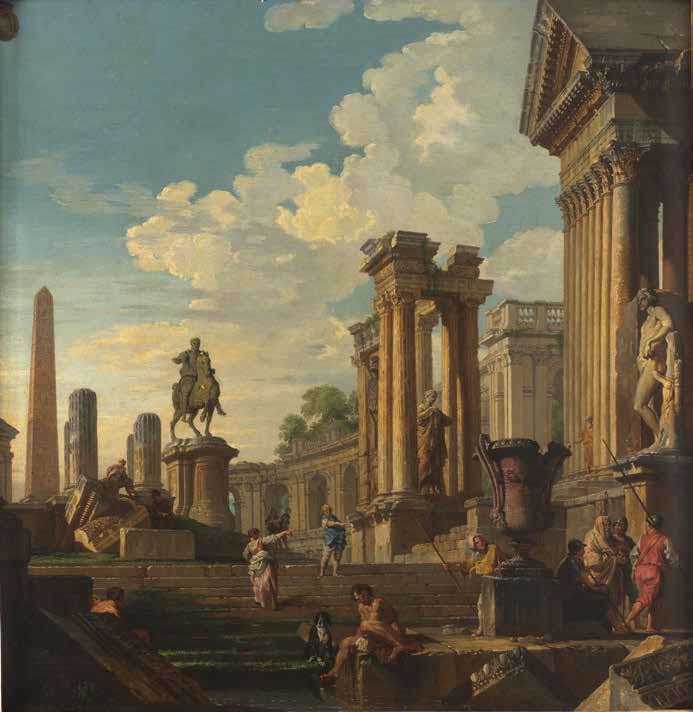
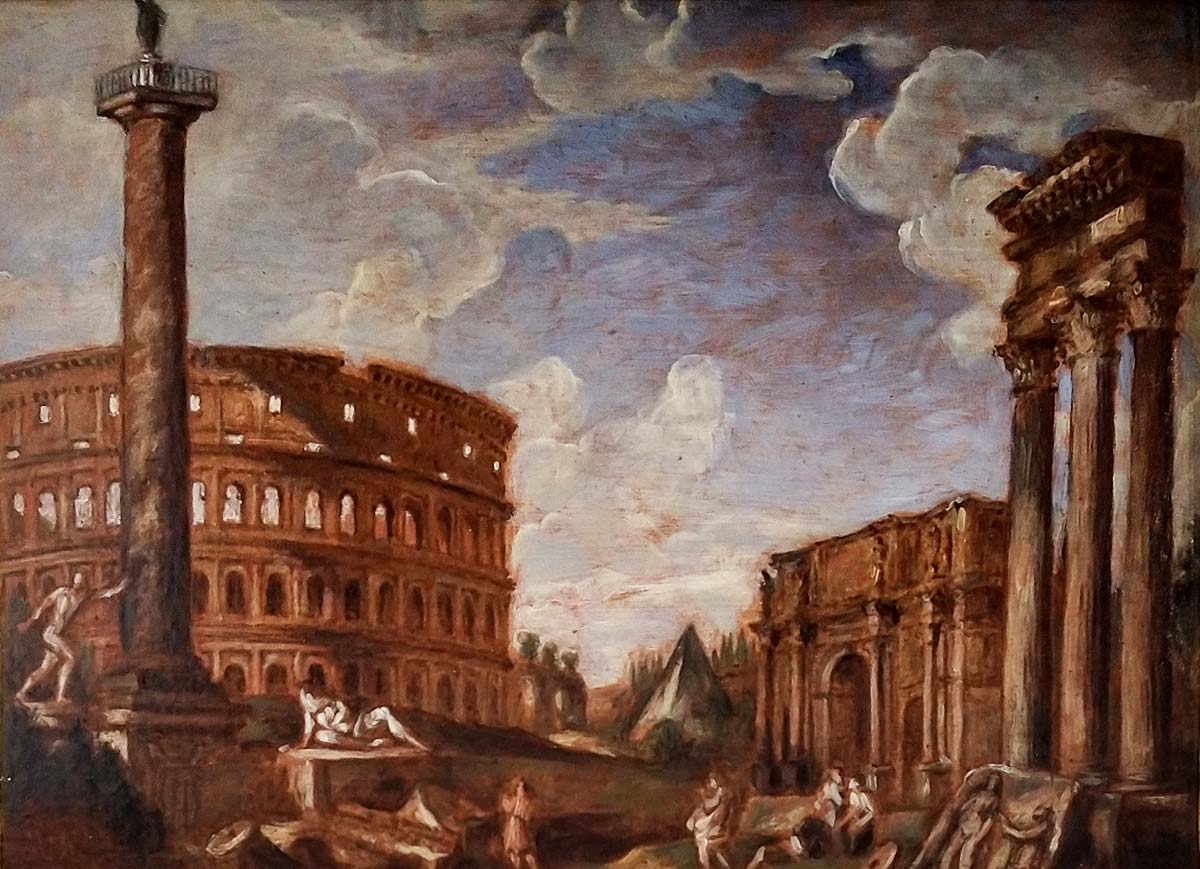

Gaining the exit, we once again return to the presence of the portrait of Panini executed by Charles Natoire: this is an unpublished work, one of the main novelties of the Piacenza exhibition, although the painting, owned by the Giorgio Baratti Collection in Milan, was studied in 2013 by Ferdinando Arisi, who left the property a manuscript note, of which the exhibition catalog provides excerpts. Arisi calls it a “splendid portrait of an old gentleman, who can be identified with the famous painter Gian Paolo Panini”: Natoire and Panini knew each other, were friends, and moreover had even worked together on a few occasions, since the Frenchman had retouched some of the Emilian’s drawings, and there are also drawings executed by the two of them in four hands. It sounds strange that the artist is nevertheless referred to as “old”: Natoire restores to the canvas a Panini at the height of his activity, in his early fifties or thereabouts, with a ruddy face and certainly looking more florid and less tired than he demonstrates in Louis-Gabriel Blanchet’s portrait, which also predates him. His facial features and even his clothing adhere precisely to Panini’s self-portrait of himself in Festino sotto un portico ionico, a work from the 1920s preserved in the Louvre where, of course, the artist appears much younger.Natoire’s portrait should nevertheless be interpreted as an artist’s tribute to his friend and esteemed colleague.
Giovanni Paolo Panini, un dossier piacentino, dedicated moreover to the memory of Ferdinando Arisi, is a solid, rigorous and linear exhibition, capable of offering the visitor an effective lunge on the young Panini: it stands out for its robust scientific structure, rooted in Ferdinando Arisi’s fundamental research, for the novelties, for the opportunity to see together many works usually kept in private collections, for the possibility of admiring some cornerstones of the artist’s early period, all combined with an affable, well-illuminated and optimally explained itinerary, with a clear apparatus that translates with supreme shrewdness, in a form suitable for the most varied audience, the contents of the catalog. The volume that accompanies the exhibition, with several essays that give the reader a complete picture of the young Panini’s activity, is a nimble tool, written in a style that eschews any pomposity and any tinsel, also suitable for a heterogeneous audience and, unlike many catalogs of ancient art exhibitions, also a pleasant read. A useful book for an exhibition that decisively marks the critical history of Giovanni Paolo Panini.
Warning: the translation into English of the original Italian article was created using automatic tools. We undertake to review all articles, but we do not guarantee the total absence of inaccuracies in the translation due to the program. You can find the original by clicking on the ITA button. If you find any mistake,please contact us.